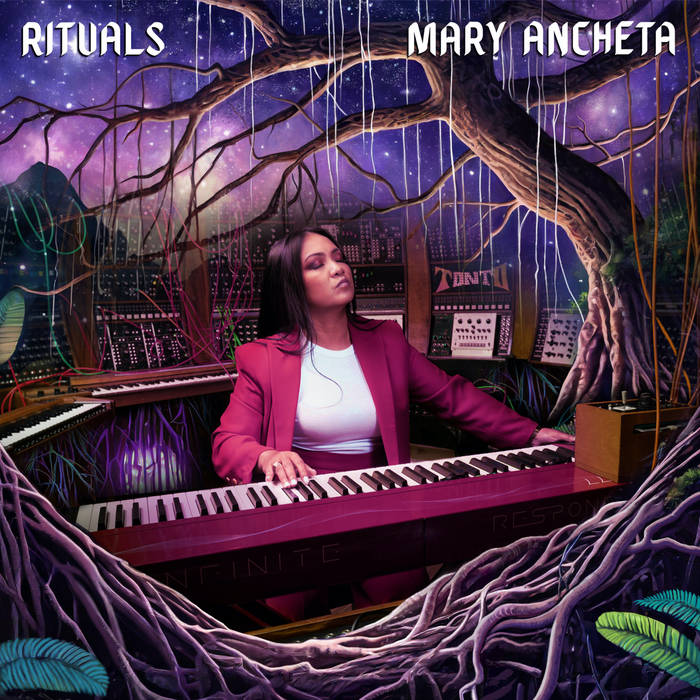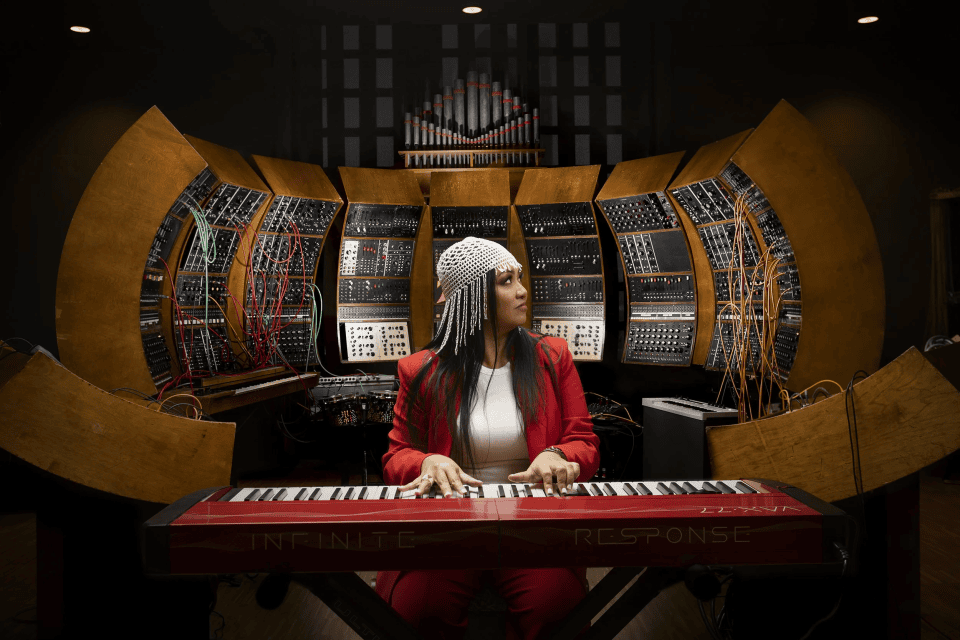Vancouver-based Filipina artist and composer Mary Ancheta’s musical journey in song is a meandering one with many twists and turns. She started improvising on the organ during her formative years in Hamilton, Ontario, where she was raised, learning to play by ear through eavesdropping on her sister’s formal lessons. She would eventually form a Britpop-inspired band with friends and, years later, pursue classical training at university, all of which would lay the foundation for her career as an in-demand touring keyboardist and composer for film and television. With over 100 placements to date, her work includes scoring the Hallmark movie My Best Friend’s Bouquet and the Netflix flick Snowpiercer, along with TV shows such as Queer Eye for the Straight Guy and The L Word.
Through it all, she has never stayed long in any genre and or let others define—or dictate—her artistic expression.
Now, after more than three decades making a living as a professional musician, travelling the world, and sampling the sounds of dozens of cultures—from Dubai to China and Taiwan to Japan—Ancheta felt the time was right to explore her own cultural roots. She describes her solo debut album Rituals, released on July 18, 2025, as “a call to her ancestors.” The record offers 11 tracks that blend sonic styles, bringing traditional instrumentation into a modern musical landscape. The result is a meditative listening experience where one feels Ancheta’s journey, from Hamilton to her ancestral homeland and all the stops in between.
The album is a love letter to the Philippines with some unexpected assistance from TONTO (a.k.a. The Original New Timbral Orchestra), the National Music Centre’s legendary synthesizer. Known for its use on iconic recordings by Stevie Wonder, the Isley Brothers, and many more, Ancheta is now part of the instrument’s storied legacy.
Inspired by a wide spectrum of artists, including Ryuichi Sakamoto, Radiohead, Miles Davis, Kraftwerk, and Tangerine Dream, Rituals reflects Ancheta’s cinematic sensibility and genre-blending style. With access to the full range of “killer gear” in NMC’s Living Collection, she was able to bring together her eclectic influences and artistic range to tell a story rooted in her ancestral heritage.

NMC Amplify chatted with Ancheta via Zoom a few weeks before the release of Rituals, and the day after she returned home from Osaka, Japan, where she performed as part of Expo 2025. The wide-ranging conversation touches on her musical journey—from her earliest memories and musical education to the creation of Rituals through exploratory music-making sessions.
Talk about your earliest musical memories and influences?
I grew up in Hamilton, Ontario and there was always music in the house. My dad listened to Nat King Cole and my mom listened to Anne Murray. The first instrument I played was the organ, not because of the church, but it’s just what I ended up playing. I had a natural ear for that sound. At first, I started playing by ear. My sister would be taking piano lessons in the house and I would listen to her play and mimic what she was doing. Eventually, I took some lessons of my own and started to write my own music.
I’m guessing, like many artists, your teenage years were pivotal to your musical development and journey?
Definitely. During my teenage years, I was a big fan of Britpop. Along with a few friends, who were also influenced by British rock, we put a band together called The Misunderstood. The only instrument I had was a Yamaha copy of a Hammond B3. I loved that synth! Later, I got a Yamaha DX7.
Besides your informal training in The Misunderstood, did you further your formal musical education after high school?
Yes. I earned a classical music degree from McMaster University. I loved just breaking down classical tunes and thinking about what went into writing them … the forms of the chords, etc., and analyzing these songs in a classical way, but also thinking about them in a pop way.
Did you continue to play in bar bands throughout university?
Yes. Much to my parents’ chagrin, I was often finishing my homework in bars and I was constantly writing songs. The Misunderstood played shows all across northern and southern Ontario, from Thunder Bay and Sudbury to Orangeville and Waterloo. I also taught piano at the Ontario Conservatory of Music while studying at Mac. When I started to look and see what else I could do after university, to be honest, I didn’t really know if music could be a career. My conservative parents were probably hoping I would continue to teach, but instead I moved to Vancouver. That’s when I started to write even more and I gained even more experience by playing with a variety of people.
Why Vancouver?
No particular reason. I had visited once before and I knew there was a music community there, but I did not know anyone who lived there other than Kevin Spencer, my bandmate from The Misunderstood who had previously moved to Vancouver from Hamilton. I eventually met more musicians like Lily Frost and I played in a variety of bands and groups. I was part of the Vans Warped Tour for a few years in a group called The Vincent Black Shadow and, in between, I did a lot of solo piano work, playing locally and in places like Vietnam and the Maldives … I was always just making music. More recently, I’ve been playing a lot with the Mary Ancheta Quartet.

Recently, the Mary Ancheta Quartet performed in Osaka, Japan. How did you get invited to play there?
I had been to Japan before with bands, but to bring my own music this time, was something really special. I was asked by the National Arts Centre to be one of the artists at the Canadian Pavilion at Expo 2025 Osaka. Just to be there and experience the Expo and check out the other pavilions and to see how everyone else represented their country, was really special.
Talk about your debut solo LP, Rituals, released on July 18. Why now, and where did the idea and concept for this record come from?
It just felt right to eventually come back to releasing something of my own. I’ve experienced so much in my career and felt that I was not a stranger to the music industry anymore, so maybe I had something to say. After all of my travels and touring, I fell into composing for film. Rituals showcases a combination of things. It showcases my influence of — and my love for — composing scores, but it also showcases my Filipino background. Growing up in Hamilton, I didn’t see a lot of people of colour, or people that looked like me, unless they were my relatives. In my classes, I was often the “different one.” This album made me want to explore more of my culture and my heritage.
Initially, I had hoped to travel to the Philippines to record traditional Filipino percussion instruments, but I started this record during the pandemic and so I could not travel. Instead, Alvin Cornista, a friend of mine and a wonderful all-around musician and saxophone player, who lives in the Philippines and runs a studio (PLANTAESHUN Music Studios) helped by recording these traditional Filipino drums from there. I was up late many nights on remote recording sessions just listening and interacting with the musicians he had assembled at his studio in the Philippines. Once I had copies of those initial percussion recordings, my co-producer Paul Sherard and I started to develop shorter ideas, almost like a hip-hop loop from these drums … we started to cut them up and then I wrote some string arrangements to accompany them. It really was a backwards way to write songs, but I didn’t want to try and force them … I wanted to hear where the percussion players would go and react to that.
Where did you get the idea to use TONTO and the curated collection of synthesizers in NMC’s Living Collection to add these percussion and string sounds?
I grew up playing synthesizers, so I just thought wouldn’t that be great to use some of the instruments in the National Music Centre’s collection. Once the idea jumped into my head, I made a plan on how it could happen. National Music Centre’s Electronic Engineer Jason Tawkin helped us and was there with us during both days of recording, so we were just not put into the studio and left to our own devices.

How did you determine what synthesizer devices to use? I’m sure the amount of instruments in NMC’s Living Collection was overwhelming
Well, we did one day of just using TONTO and the other day was spent using the instruments that they have in Live Room B. It was incredible and definitely overwhelming for sure. We could not use them all, so we basically went down the list of what was available. Some of them we knew and others we Googled to learn more about what they did and how to use them. We then made a giant list of all the ones we thought would make sense for the pieces we had written and then we just tried to record with as many of them as we could, figuring we could edit everything later. We would record with one while Jason (Tawkin) got the next one ready … it felt like being a kid in a candy store.
Any of those “pieces of candy” cooler than others?
For sure. There was one Jason showed us—and that we ended up using—that looked like a game of Battleship. You have to move all of these little pegs to play it and we were told that Pink Floyd used it on one of their records.
Despite your parents cringing all those decades ago when you moved to Vancouver and decided to follow a non-traditional career path (at least in their opinion), do you think they will enjoy listening to this love letter in song that you’ve created to their home?
I hope so. They actually haven’t heard the record yet as the last time I was home, I didn’t get a chance to play it for them, but I will be interested to see how many of these Filipino instruments they know. Some of them I knew, like the kulintang, which is similar to a gong, but some of the others are definitely not as common. The end result of the combination of all of these traditional instruments with the strings and synthesizers creates a kind of “loopiness”—especially the sound of the kulintang—that feels meditative.